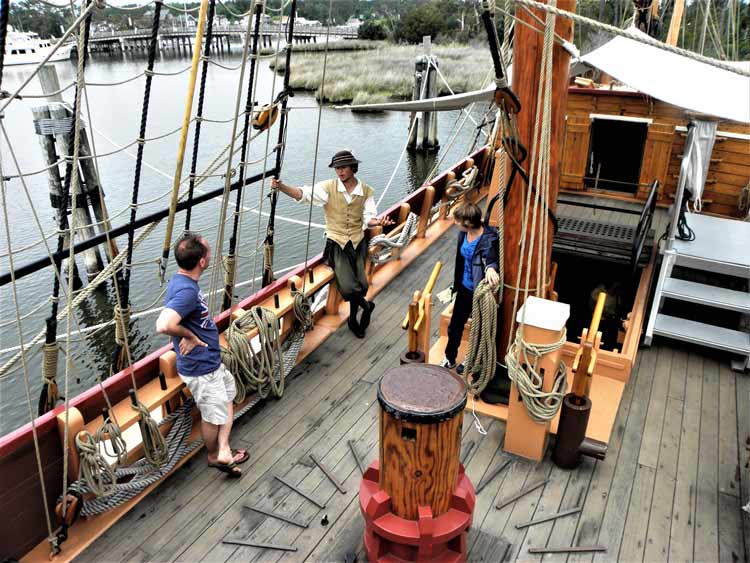

I stood frozen with fear, unable to move. The terrifying image drew closer, his curved sword swinging wildly. Just as he seemed about to separate my head and body, I snapped back to reality, left my all-too-real daydream about Blackbeard the Pirate behind, and moved on to the next exhibit in the museum in the Outer Banks.
The dramatic if somewhat grisly story of Blackbeard is but one display that transforms the Graveyard of the Atlantic Museum in Hatteras, North Carolina, into a memorable lifelike experience. That eclectic collection is among attractions which make the Outer Banks – the chain of narrow barrier islands that parallels the state’s Atlantic coastline – into much more than just another sun-and-sand vacation destination.
No wonder Forbes has included it among “20 Top Places Americans Are Dreaming About Right Now,” and a renowned seashore expert included one of its beaches among his list of the most outstanding in the country.

Colorful History Adds to the Appeal of the Outer Banks of North Carolina
Another appeal is how the Outer Banks’ past comingles with life there today. Tiny family cemeteries stretching back generations are hidden behind homes. Some houses contain timbers that were salvaged from the hundreds of ships that fell prey over centuries to the treacherous waters off the coast.
The Outer Banks became a magnet for vacationers in the 1830s, when families of wealthy North Carolina planters found refuge there from the summer heat. They were followed by sportsmen drawn by outstanding fishing and hunting that Native Americans had discovered centuries earlier.
Beaches abound along North Carolina’s Outer Banks
Today, beaches which are strung out along the 130-mile-long Outer Banks are the major appeal for many visitors. Cape Hatteras National Seashore runs for 70 miles and offers the largest stretch of undeveloped beaches on the East Coast. Each of the tiny villages nestled between those stretches of sand has its own distinctive characteristics.
Many visitors rank Corolla (pronounced coh-RAH-luh) and Duck, the northernmost towns, as the two prettiest. Duck has a wooden boardwalk that skirts a bay, leading through pockets of woods where bird calls are the only sound.
Kitty Hawk, Kill Devil Hills and Nags Head form the commercial hub of the Outer Banks, complete with a strip-mall atmosphere and two attractions worth a stop. It was at Kitty Hawk where, on December 17, 1903, Wilbur and Orville Wright made the first controlled power flights.
Visitors often are surprised to learn that their longest journey lasted only 59 seconds and covered just 852 feet. A museum houses a full-scale replica of their rickety aircraft and other memorabilia that tell the story.
Nearby Jockey’s Ridge State Park is home to the tallest sand dune on the East Coast. Winds constantly reshape the dramatic ridge, causing the dune to vary in height from 80 to 100 feet.
Reminders of Native Americans, Early Colonies and the Civil War at the Outer Banks of North Carolina
Roanoke Island became the site of the first English colony in the New World in 1857. A good place to begin your exploration is Roanoke Island Festival Park, where the life of Native Americans who originally inhabited the area is recreated. Longhouses, a dance circle and planting and harvesting areas set the mood. Interactive exhibits appeal to generations of family visitors.

To relive another chapter of the story, clamber aboard the Elizabeth II, a sailing ship representative of seven British vessels that arrived during the 16th century. Costumed interpreters describe the small craft, and entertain landlubbers with dramatic tales of the perilous voyage, speaking in a thick brogue that echoes the dialect of that time.

The history lesson continues at the Roanoke Adventure Museum, where 400 years of Outer Banks past are explored. From early pirates to the Civil War, from boat-building to shipwrecks, virtually every facet of life as it used to be gets its due.
Sunken Ships Tell Part of the Story of North Carolina’s Outer Banks
In Hatteras Village, the aptly named Graveyard of the Atlantic Museum is chock full of dramatic exhibits which chronicle the tragic tale of more than 2,000 ships that met their fate on the treacherous offshore shoals. Many were sailing vessels that went down during the 18th and 19th centuries.

Others were cargo carriers heading for England during World War II, which were sunk by German submarines that lurked surprisingly close to our country’s East Coast. Parts of several shipwrecks still are visible today along beaches or in shallow water at low tide.
Among other vivid exhibits at the museum are displays about the Civil War ironclad U.S.S. Monitor, ship bombing demonstrations by General Billy Mitchell off the Cape Hatteras coast in 1921, and lifesaving and rescue operations. Of course, there’s a section devoted to the notorious Blackbeard who, after his life of marauding, was killed in the area.
Lighthouse buffs will think they’ve gone to heaven, with three towers that mark this stretch of the Outer Banks, all of which were first lit in the 1870s. The Cape Hatteras light claims fame as the tallest brick beacon in the country.
Adding to this historical and cultural mélange is a list of other pursuits that offer something-for-everyone variety. They range from hiking to hang gliding, kayaking to kiteboarding, sailing to surfboarding, along with fishing and crabbing. Oh yes, and one of my favorite beach pastimes: relaxing on some of the finest sand anywhere with a good book.
If you go
For information about visiting the Outer Banks, call 877-629-4386 or log onto The Outer Banks.
- Broward County, Florida: When the Winter Sun Hides Behind a Cloud - April 16, 2024
- Nature is Neat in Broward County, Florida - April 1, 2024
- Margaritaville: A Time-Honored Memorial to Jimmy Buffett - March 15, 2024

